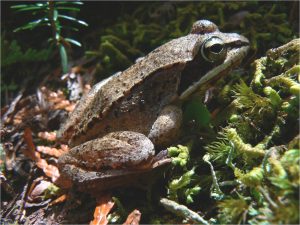Wood Frog Fact Sheet

Image source: A. Shearin, Maine Department of Inland Fisheries and Wildlife
Wood frogs are a terrestrial species that can be found in all types of forests. It is the only frog species that survives above the Arctic Circle, aided by the ability to partially freeze. Within northern ecosystems, the wood frog controls insect populations through its feeding behavior.
Appearance: Color variations for this species include brown, tan, rust or shades of green and gray. Wood frogs are identified by a white line above the lip and a dark “robber’s mask” across the eyes. Body size is typically less than 2.5” long. Females are often larger and lighter in color than the males. Sexes can be distinguished by examining the shape of the webbing found in the hind toes; females have concave webbing, while males are convex.
Feeding: Wood frog larvae are known to eat algae, detritus, and the larvae of other amphibians. Adults consume a variety of insects and small invertebrates, including spiders, beetles and moth larvae.
Life History: Wood frogs emerge from hibernation when warm rainfall thaws them. They participate in a yearly migration that brings them to vernal pools for breeding, starting in late February and March. Males search for a mate by hugging other frogs until they find one who is round enough to be carrying eggs. Females lay approximately 1000 eggs, often in the deeper sections of the pools. Communal egg masses are attached to vegetation within the pools. Eggs will hatch in 10-30 days, depending on the temperature. Tadpoles typically take a little over a month to mature into frogs.
Sources and Additional Information:
“Wood frog”. Missouri Department of Conservation. 2014. Web. 2 July 2014. http://mdc.mo.gov/node/3927
Kiehl, K. 2011. “Lithobates sylvaticus” (On-line), Animal Diversity Web. Accessed July 02, 2014 at http://animaldiversity.ummz.umich.edu/accounts/Lithobates_sylvaticus/
“Wood frog”. Rhode Island Vernal Pools, URI. http://www.uri.edu/cels/nrs/paton/LH_wood_frog.html
Knox, C.B. 1999. Wood Frog. Pages 111-118 in Hunter, Malcolm L., Aram J. K. Calhoun, and Mark McCollough, editors. Maine Amphibians and Reptiles. The University of Maine Press, Orono, Maine.
